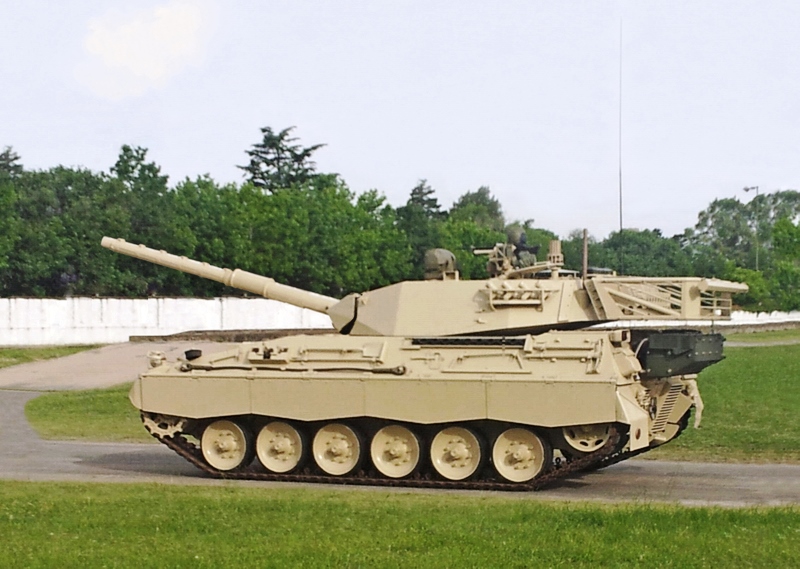Oso ("Bear")
Type: Main Battle Tank
Place of Origin:
Spain
Service History
In Service: 1979-Present
Used By: Spanish Army
Wars: Spanish-Moroccan War (1975-1991), Spanish Revolution of 1992
Production History
Designer: Empresa Nacional Santa Bárbara de Industrias Militares SA
Manufacturer: Fábrica de armas de Trubia
Number Built: 2,000
Specifications
Weight: 30.5 Tons (33.6 Short Tons)
Length: 6.75 M
Width: 3.25 M
Height: 2.42 M
Crew: 4 (Commander, Driver, Gunner, Loader)
Armor: RHA Steel
Main Armament: 105 MM FM K.4 Modelo 1L Tank Gun
Secondary Armament: 2 x 7.62 MM Machine Guns
Engine: MTU MB 833 Ka 500 6-Cylinder Diesel Engine; 720 HP
Suspension: Torsion Bar
Operational Range: 590 KM
Speed: 75 KM/H
By the early 1960's, Spain had assembled one of the largest armies in
Europe. Francisco Franco's "military first" policies had resulted in the Spanish Armed Forces possessing nearly as many tanks per capita as Greater Germany or the Italian Social Republic. Some 1,800
Panzer VII's and 1,700
Panzer VIII's made up the bulk of Spain's armored forces. Unlike the RSI or France, Spain did not produce its own license-built copies of German tanks. Tank production at Bilbao's
Fábrica de armas de Trubia consisted of assembling knock-down kits and manufacturing spare parts for Spain's armored vehicles. After Ramon Serrano Suñer condemned the German invasion of Croatia in 1968, Spain began to take an independent course in European affairs, forging ties with the United States and Great Britain.
Unfortunately, Suñer's policies meant Spain faced great difficulty when acquiring new weapons from its traditional suppliers. Thus, Suñer and the Chiefs of the General Staff ordered Spain's I
nstituto Nacional de Industria to begin work on an indigenous tank program. The obvious place to start was by reverse-engineering the Panzer VII/VIII. Unfortunately, the dependable Panzer VII/VIII had been rendered obsolete by the introduction of the Leopard I in 1968. Spanish engineers came up with an ingenious solution, namely acquiring a Leopard I from the United Arab Republic and reverse-engineering it.
The resulting tank was essentially a hybrid of the Leopard I and the Panzer VII/VIII. The
Oso ("Bear") entered production in 1979, becoming the primary tank of the Spanish Armed Forces in their war with Morocco. Despite proving to be a match for Moroccan M48's, there was significantly less to the
Oso than met the eye. In 1985, the CIA was able to get its hands on a captured
Oso, courtesy of Morocco While superficially resembling a Leopard I, the
Oso owed more to the Panzer VII/VIII than it did to the Leopard. Its transmission was unreliable, it lacked a laser range-finder or an electronic ballistics computer and it was fitted with obsolete night-vision equipment.
In addition to being Spain's first indigenous Main Battle Tank, the
Oso has the distinction of being the only tank ever exported by Spain: some 400
Osos are believed to have been exported to the U.A.R. during their war with Iran.
Lince ("Lynx")
Type: Main Battle Tank
Place of Origin:
Spain
Service History
In Service: 1986-Present
Used By: Spanish Army
Wars: Spanish-Moroccan War (1975-1991), Spanish Revolution of 1992
Production History
Designer: Empresa Nacional Santa Bárbara de Industrias Militares SA
Manufacturer: Fábrica de armas de Trubia
Number Built: 500
Specifications
Weight: 49 Tons (54 Short Tons)
Length: 7.10 M, 9.068 M (Length With Gun)
Width: 3.74 M
Height: 2.50 M
Crew: 4 (Commander, Driver, Gunner, Loader)
Armor: Composite Armor (Prototypes), RHA Steel (Production Models)
Main Armament: Rheinmetall 120 MM L/44 Tank Gun
Secondary Armament: 2 x 7.62 MM Machine Guns
Engine: MTU MB 871 Ka 501 12-Cylinder Diesel Engine; 1,200 HP
Suspension: Torsion Bar
Operational Range: 550 KM
Speed: 70 KM/H
By the late 1970's, Spain's relationship with the United Nations had soured, due to its refusal to pull out of the Rif and the Sahara. Spain's relations with Germany began to improve, but not to the point where Germany was willing to allow Spain to license-produce its newest, most powerful tank. Indeed,
Reichspräsident Kurt Waldheim is reported to have said "I would sooner shoot myself in the foot than give that megalomanic [Serrano Suñer] a single division of Leopards!" Nevertheless, Spain managed to acquire a handful of Leopard II's for evaluation and promptly went about reverse-engineering them.
By 1986, Spain had rolled out the first protoype for the
Lince ("Lynx"). Theoretically, the
Lince should've been one of the most powerful Main Battle Tanks on the planet, but the increasingly prostrate condition of the Spanish economy resulted in - as one Spanish tank commander put it - "a cat without claws." Spain lacked the expertise to replicate the Leopard II's advanced fire control system and night-vision equipment, thus the
Lince was fitted with the same obsolete package as the
Oso.
On top of it all, Spain struggled to replicate the Leopard II's composite armor, as well as its main gun. While Spain was able to utilize RHA steel to make up for the
Lince's lack of composite armor, it was never able to successfully replicate the Leopard II's 120 MM cannon. The Spanish-built copies of the L/44 Tank Gun had dramatically shortened main gun tube lives, less than half that of their German counterparts.
Quality control issues, along with the poor state of the Spanish economy resulted in only 500 out of a projected 1,500 being produced before the end of the Spanish-Moroccan War and the fall of fascism in Spain.
















